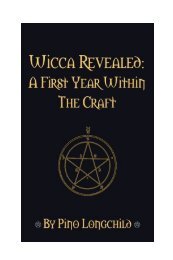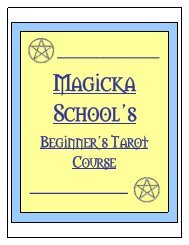A Magickal Herball Compleat.pdf - Magicka School
A Magickal Herball Compleat.pdf - Magicka School
A Magickal Herball Compleat.pdf - Magicka School
You also want an ePaper? Increase the reach of your titles
YUMPU automatically turns print PDFs into web optimized ePapers that Google loves.
For several centuries, a whole range of causes, which I could not begin to enumerate, have led to<br />
the downgrading of that divine science, clinical medicine, to the level of a wretched, money-grubbing<br />
exercise in the whitewashing of symptoms and a demeaning traffic in prescriptions, in fact, God<br />
forgive us, to a more mechanical trade in which Hippocrates is lost to sight amidst a rabble of<br />
charlatans. [3]<br />
The medicine of his age did not impress Samuel then, and by 1784 he had given<br />
up his practice in favour of writing and translating. It was while working on<br />
William Cullen's A Treatise on Materia Medica [4] that he came across an interesting<br />
fact that was to change his life.<br />
In this book it was claimed that a liquid made from the finely ground bark of<br />
cinchona, a Peruvian tree, would make an effective cure for malaria [5]. The<br />
curative properties of this bark were already well known in Europe and had been<br />
used to treat both Louis XIV of France and Charles II of England [6].<br />
Hahnemann took issue with the claim that its potency was caused by the fact that<br />
it was an astringent -after all, other astringents had no effect on malaria [7]- and<br />
decided to test this claim for himself. Over a period of days he took high doses of<br />
cinchona and found that the bark produced symptoms that he claimed were<br />
reminiscent of malaria:<br />
I took for several days, as an experiment, four drachms of good china (cinchona) daily. My feet<br />
and finger tips, etc., at first became cold; I became languid and drowsy; my pulse became hard<br />
and quick; an intolerable anxiety and trembling (but without a rigor); trembling in all the limbs;<br />
then pulsation in the head, redness in the cheeks, thirst; briefly, all those symptoms which to me<br />
are typical of intermittent fever, such as the stupefaction of the senses, a kind of rigidity of all<br />
joints, but above all the numb, disagreeable sensation which seems to have its seat in the<br />
periosteum over all the bones of the body - all made their appearance. This paroxysm lasted for<br />
two or three hours every time, and recurred when I repeated the dose and not otherwise. I<br />
discontinued the medicine and I was once more in good health. [8]<br />
Later he would create similar experiments with digitalis (foxglove) and belladonna<br />
[9]. As a direct result of these he was able to begin to formulate the idea "that which<br />
can produce a set of symptoms in a healthy individual, can treat a sick individual who is<br />
manifesting a similar set of symptoms" [10] and write that:<br />
Every effective drug provokes in the human body a sort of disease of its own, and the stronger the<br />
drug the more characteristic, and the more marked and more violent the disease. We should<br />
imitate nature, which sometimes cures a chronic affliction with another supervening disease, and<br />
prescribe for the illness we wish to cure, especially if chronic, a drug with power to provoke<br />
another, artificial disease, as similar as possible, and the former disease will be cured: fight like<br />
with like. [11]<br />
Hahnemann published his results in Hufeland's journal in 1796 under the title<br />
Experiment on a New Principle to Find Out the Healing Power of Medicinal Substances and<br />
importantly stated that “similia similibus curentur” or like could be cured by like.<br />
In his Organon der Heilkunst or Medical Primer he stated that:<br />
151




